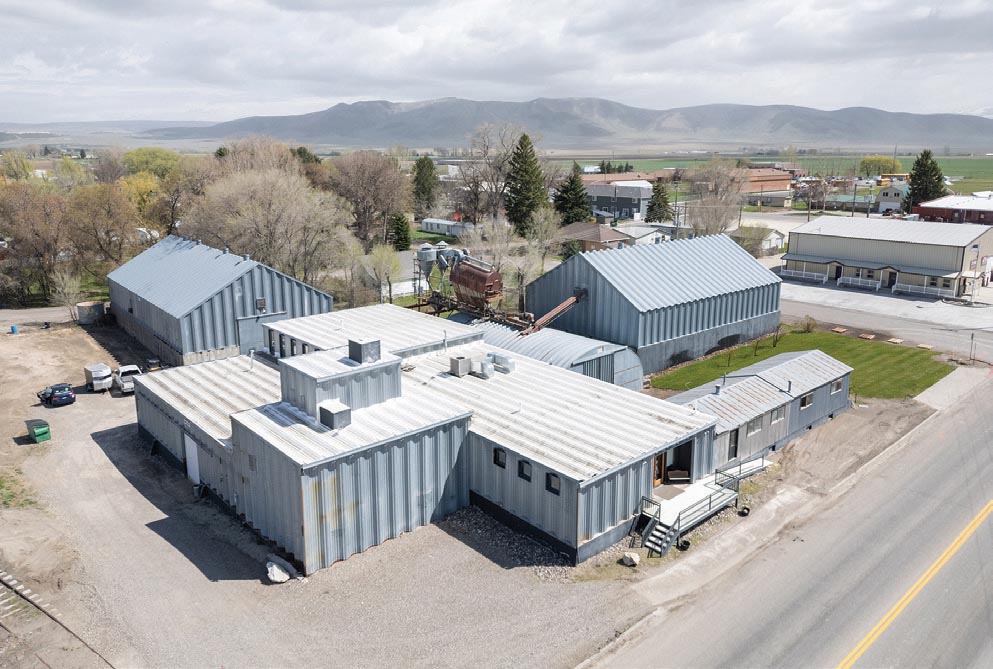
02 May In The Studio: The Gift of Space
Half a century ago, when he was a member of the Minico High School basketball team, Robert Moore would drive harvested dried pinto beans or Great Northerns from his family’s farm to the local Hazelton, Idaho, warehouse of wholesalers Morgan-Lindsay. He had no inkling then that someday another warehouse built by that same company beside the railroad tracks in Declo, 30 miles east of his hometown, would become the studio of his dreams, an expansive space ideally suited to creating his vivid, large-format impressionist paintings of the natural and human-made worlds.
A lot of hard work, determination, and faith buoyed Moore on his journey through those years — not to mention an artistic talent that first showed itself in second grade. “We were doing drawings celebrating Thanksgiving, and I drew a pilgrim in the center of the table with turkeys sitting all around it,” he chuckles. “I was just trying to get attention, and the teacher refused to put mine up on the wall. But my mother was proud of that sketch and always held onto it.”
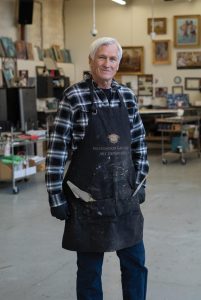
Ready to work, Moore stands in his main studio space, wearing an apron “to keep my wife from being sad when I come home with paint on my clothes.” Its pockets keep palette knives and a brush in easy reach. Since his days as a student at the ArtCenter College of Design, Moore has worn latex gloves to protect his hands from toxic substances in oil paints.
Moore continued to excel at art — and, as he grew to a height of 6 feet 3 inches, also basketball. A good all-around student, he won an athletic scholarship to Concordia College in Portland, Oregon, then moved on to the College of Idaho in Caldwell. His father had urged him to study law, but Moore soon realized an attorney’s life was not for him, and he enrolled simultaneously in Boise State’s art program. Eventually, he graduated from Eastern Oregon University in La Grande with a degree in art education and returned to his old high school to teach art and coach the girls’ basketball team.
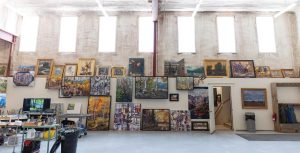
In the main studio, an array of high windows welcomes north light. Moore’s works are displayed below them, including three canvases (two resting on the floor) that represent his recent explorations in a more abstract style.
It didn’t take long for him to realize, though, that “art was my passion, and if I worked hard enough and didn’t quit, I would be able to succeed.” That first year back, he applied to and was admitted as an illustration major at the esteemed ArtCenter College of Design in Pasadena, California.
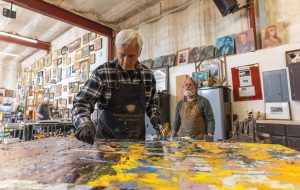
Using both hands — “I taught myself to be ambidextrous since I broke my wrist in my early 20s” — Moore lays down strokes of color on a painting in progress. Because his canvases are so large, he usually prefers to place them horizontally on a rotating table. Standing behind Moore and ready to assist him is one of his current apprentices, artist Joseph McKay.
That’s where Robert Moore’s dreams finally soared, so much so that he was among the rare students selected for their nine-term honors program, bestowing an extra term “to pick any classes that I wanted.” For seven of those nine terms, he studied under revered contemporary figurative impressionist Dan McCaw. “My goal became to paint like McCaw, to teach like McCaw teaches, and to bless people like he did. He was very generous and humorous and just a wonderful man and teacher. One of the things that stuck out to me was he said, ‘Don’t paint an ice cream cone the way it looks. Paint an ice cream cone the way it tastes.’”

Moore’s studio rises as a prominent landmark beyond the “Welcome to Declo” sign.
That advice resonated with Moore, and for a specific reason. From age 5, he’d known he was color blind, seeing the world mostly in yellows and blues. “I was playing Go Fish with my cousin. I asked him for his red cards and then laid down two reds and two greens and told him that I’d won.”
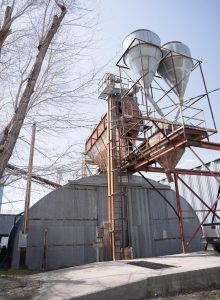
Resembling an abstract sculpture, an array of weathered industrial hoppers on top of the roof speak to the building’s former days storing dried beans.
So, at ArtCenter, Moore delved deeply into color theory. “I took a class on it three times because I wanted to understand the order that made color feel natural,” he says. “A color is only wrong if it’s out of order with the other colors around it.” Moore trained himself to organize his paints to maintain order regardless of his chosen colors. As a result, he might render a snowy mountainscape in bold strokes of purple, blue, pink, and gray, or aspen trunks in green, lavender, turquoise, and black, yet perfectly capture reality. “I could place 12 different colors of sunglasses on a table, and you could put on any pair and go outside, and the world would look beautiful to you,” he explains. “The beauty is in the color relationships, in the order that God put into all of creation.”
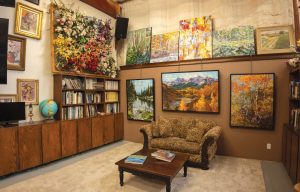
A library area beyond where Moore paints includes his reference books and, above the bookcase, a grid on which silk flowers are stored in a colorful array for his still-life students.
With such soaring inspiration and solid grounding, Moore’s fine art career was launched well before graduation. On a painting excursion to Kerrville, Texas, with fellow students early in his second year, he attended a workshop taught by members of the Cowboy Artists of America. “One of them, Robert Duncan, called up Trailside Galleries and told them they needed to look at my work.” Moore’s art can now be found in top galleries across the West.
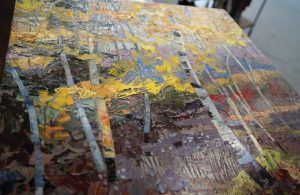
A closeup view of a work-in-progress displays the dynamic, thick impasto Moore achieves.
Moore returned home to Idaho to paint. He restored the first home he’d grown up in, married his wife Rebecca, and repaired a century-old barn for his studio. As their family grew with six children, the Moores moved to a bigger home in Declo, and he set up a new studio in an old church in Albion, 8 miles away. “That was where I painted for years, until I started growing out of it.”
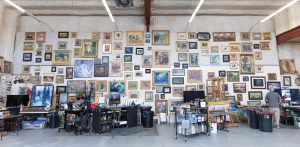
On the main studio space’s opposite long wall are separate painting stations where Moore’s apprentices can work on their creations: standing on the right, painter Garth Williams, affectionately known as “Wild Dog,” who lauds Moore as “a wonderful, respected man, well-loved in our community”; then the easel of painter Ryan Shuman; next to that, a carpeted area for Cody White, seen seated; and in the corner, a workspace for Robbie Moore, the painter’s son.
“Growing out” had multiple meanings. With his kids in school in Declo, he wanted to work closer to home. Also, his canvases kept getting bigger, with current works as large as 6 by 8 feet. And he needed extra space to accommodate the apprentices he regularly takes on out of his desire to help others and his need for assistance in working at such a grand scale — not to mention upwards of 25 students that attend his workshops.
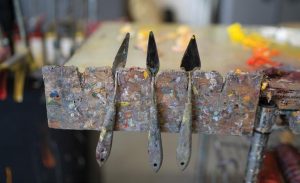
Palette knives freshly cleaned by an apprentice stand ready for Moore to use.
So, 14 years ago, Moore began seeking some place bigger. He found it at the end of an old railroad line near the “Welcome to Declo” sign. “The father of one of my current apprentices was a student of mine then, and he stopped at this maybe 10,000-square-foot warehouse and asked if the current owners would be interested in selling. They were. So, I started transforming it from a big, dark, dirty space, cleaning it up and putting in windows and insulation and new floors and walls. My apprentice at the time, Dave Mensing, was an architect back then, and he drew up the plans. I couldn’t ask for anything better.”
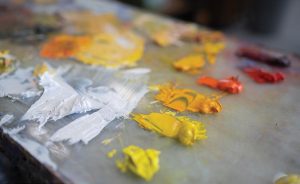
Oil paints are arranged on Moore’s glass palette in the order of the spectrum.
The transformation seems nothing short of a miraculous distillation of Moore’s work, life, and faith. His painting space occupies much of the main room, with a ceiling soaring as high as 30 feet and lofty windows providing abundant natural light. Moore can move about and paint at ease, whether a canvas rests horizontally on a table or vertically on an easel. Nearby sits a large pane of heavy-duty glass that serves as his palette, with his colors carefully arrayed.
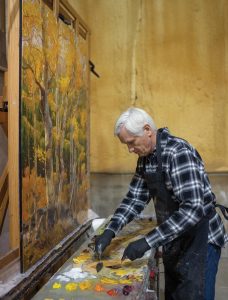
Moore positions an almost-finished canvas upright on an easel to add finishing touches.
In one nearby corner, tucked beneath a lower section of ceiling, shelves hold a medley of silk flowers and other items for the still lifes that students paint under Moore’s guidance during workshops. Two large TV monitors can display images from ceiling-mounted cameras, enabling him to demonstrate his techniques. “I can also watch basketball games on them,” he adds. There’s even a half-court with a hoop at the other end of the room for impromptu pick-up games. “All three of my sons are 6-foot-3 like me, so we’ve had a lot of fun with that.” Other casual competitions await in an adjacent gallery room, where ping pong and pool tables, lounge chairs, and a grand piano share the space with Moore’s paintings and those of friends, family, and students.
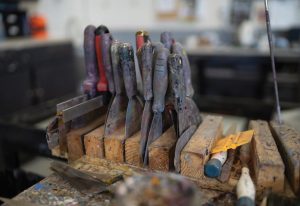
Moore’s organized collection of palette knives and other tools helps the artist apply paint in thick, generous amounts.
Perhaps the most telling aspect of Moore’s workspace, however, can be found lining its towering walls: dozens of artworks, displayed floor to ceiling in the old-fashioned salon style. Most of them are by his assistants, a sign of the quiet satisfaction the artist takes in their achievements. “This studio,” he concludes, “allows me to have the apprentices. My gifting is to encourage and to teach, to facilitate other artists to reach their dreams.”
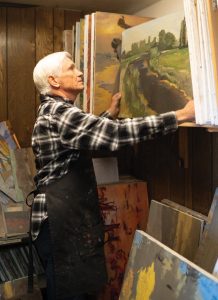
Moore looks through a selection of paintings neatly stored in his Declo, Idaho, studio.
Moore’s paintings can be found at Broadmoor Galleries in Colorado Springs, Colorado; Dana Gallery in Missoula, Montana; Manitou Gallery in Santa Fe, New Mexico; InSight Gallery in Fredericksburg, Texas; Kneeland Gallery in Ketchum, Idaho; Montgomery Lee in Park City, Utah; Rimrock Gallery in Prineville, Oregon; Altamira Gallery in Jackson Hole, Wyoming; and Raitman Galleries in Vail and Breckenridge, Colorado.
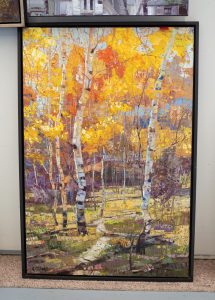
The recent 60-by-40-inch The Narrow Path displays Moore’s virtuosity.
Based in San Rafael, California, Norman Kolpas is the author of more than 40 books and hundreds of articles. He also teaches nonfiction writing in The Writers’ Program at UCLA Extension.
As a wedding and portrait photographer, Erik Hill prides himself on helping couples create “future nostalgia” by documenting events and moments they will recall with joy and nostalgia.






No Comments